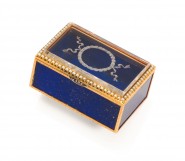Lot #65 - Max Dupain
-
Auction House:Deutscher and Hackett
-
Sale Name:Important Australian + International Art
-
Sale Date:29 Aug 2018 ~ 7pm (AEST)
-
Lot #:65
-
Lot Description:Max Dupain
(1911 – 1992)
Sunbaker, 1937
silver gelatin photograph
37.0 x 40.0 cm
signed and dated in image lower right: – Max Dupain '37 –
REFERENCES: Newton, G., "Max Dupain: Photographs 1928 – 80", The David Ell Press, Sydney, 1980, p. 64 (illus. another example) "Max Dupain's Australia", Viking Press, Sydney, 1986, p. 104 (illus., another example) Ennis, H., "Max Dupain: Photographs", National Gallery of Australia, Canberra, 1991, p. 18 White, J., Smee, S. and Cawood, M., "Dupain's Beaches", Chapter and Verse, Sydney, 2000, p. 69 (illus. another example) Annear, J., "The Photograph and Australia", Art Gallery of New South Wales, Sydney, 2015, pp. 40, 50, 104 (illus., another example), 294 -
Provenance:Private collection Sydney, a gift from the artist; Private collection, Sydney
-
Notes:There are only a handful of artworks that have been as influential on the creation of a national psyche as Max Dupain’s photograph, "Sunbaker", 1937. Its enduring power derives from the incorporation of twin social mythologies prevalent during the inter-war period: that of the ‘old sunburnt country’ and physical health as a symbol for the strength and potential of Modernity. "Sunbaker" would come to represent in a single recognisable image the new outdoor Australian way of life: the simplicity of composition, dramatic contrast of light, and purity of context coincided to create a powerful and iconic image. Judy Annear, Curator of Photography at the Art Gallery of New South Wales, Sydney attributed this to Dupain’s ability to ‘adroitly harness a moment in time that came to symbolise the ambitions of a nation’.1 The story of how this modest snapshot from within one of Dupain’s holiday albums, compiled following a trip to the south coast of New South Wales in 1937 with his friends Harold Salvage and Chris Vandyke, would become the subject of such massive exposure in the latter half of the 20th century is a tale of coincidence. This version of "Sunbaker, "identical in size and format to those in most of Australia’s state and national collections, is the second version of two pictures that Dupain took at the same time in 1937. The artist chose to publish the other, "Sunbaker II", 1937, in a monograph of his work in 1948, and sometime after this, its negative was lost.2 It wasn’t until 1975, thanks to the combined marketing power of a retrospective exhibition of Dupain’s photographs and a later survey of Australian photography, that the image was presented to wide national audiences. The "Max Dupain: Retrospective" at the Australian Centre for Photography, Sydney in 1975 used "Sunbaker" as a promotional image and four years later, it was illustrated on the back cover of the catalogue for "Australian photographers: the Philip Morris Collection". The images in "Australian photographers" were personally selected by James Mollison, founding director of the National Gallery of Australia, Canberra.2 In formal terms, the composition of "Sunbaker" marked a departure from the artist’s earlier surrealist studio montages, which often featured full-length female nudes. Creating a visual correlation between the geometric solidity of a pyramid and the physical strength of a young man, Dupain’s photograph sits in a neat nexus between modernist formalism and an idealistic focus on physical wellbeing in the interwar years. This young man, with his bronzed skin and muscles glistening with salt, sand, sweat and seawater would come to embody the ideal antipodean (ironically, he was an Englishman who had recently emigrated to Australia). The subject does not call out to the viewer, encouraging them to emigrate to the idealised southern land of sunshine and good health, as he would have in contemporary advertisements. Instead, we as viewers, intrude on his intimacy and respite, the reduced form of his recumbent body jutting out into the foreground of the photograph, almost transcending the barrier of the picture plane. The austere simplicity and lack of spatial context of Dupain’s composition creates a timeless and universal space where man is at one with the land, resting on the horizon’s edge. 1. Annear, J., "Photography: The Art Gallery of New South Wales Collection", Art Gallery of New South Wales, Sydney, 2007, pp. 142 – 149 2. Newton, G., ‘The Sunbaker’ in White, J., "Dupain’s Beaches," Chapter & Verse, Sydney, 2000, p. 68 3. Annear, J., "Photograph and Australia," Art Gallery of New South Wales, Sydney, 2015, p. 46 LUCIE REEVES-SMITH
-
Estimate:A$30,000 - 40,000
-
Realised Price:
-
Category:Art
This Sale has been held and this item is no longer available. Details are provided for information purposes only.










